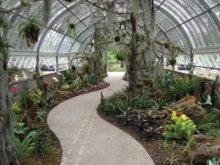 A recreation (using water) of the Spindletop gusher, that spewed 100, 000 gallons of crude a day into the air in 1901 and made Beaumont, Texas, a rich town.
A recreation (using water) of the Spindletop gusher, that spewed 100, 000 gallons of crude a day into the air in 1901 and made Beaumont, Texas, a rich town.
Beaumont, Texas: Wildlife and Nightlife in the Heart of the Oil Patch
By Max Hartshorne
I'd never set foot in the Republic of Texas until last month, when I discovered Beaumont, about 90 minutes east of Houston. It's a city with big plans afoot.
Their sidewalks are being ripped up and replaced with quaint brick, and black iron streetlights are being added to give the main drag, Calder Avenue, an old time feel. The reason is rainage but the effect will be to make it look more old timey and charming.Things are looking up in this city of refineries.
 My first evening was spent on a couch, eating passed tapas at Easy's, emblematic of the relaxed charm of East Texas.
My first evening was spent on a couch, eating passed tapas at Easy's, emblematic of the relaxed charm of East Texas.
Instead of a sit-down meal, we opted for martinis and little plates and shared every taste. It was a great way to sample the big menu of little delights, from slivers of steak to fried artichokes and "éasy trash, " seafood sauteed in black butter sauce. We left the azure-colored martini in the middle of the table as a lighted centerpiece.
Proprietor Wayne Inwerson says Easy's goes after an older crowd, so with this menu and a dress code, they can keep the clientele to the grown-ups like us who aren't going to raise a ruckus, and will spend some dough on good food.
Since Easy's is located on one of the city's main streets, Calder Street, it's right on the way to center city, and the outdoor patio is a great attraction. My cold northeastern sensibilities alerted me to how unusual it was to be outside at 9 pm without a jacket, as people can do down here in the South of Texas.
 "Beaumont was once bigger than Houston, " a local tourism official told me. The city was founded in 1850, and soon after they began to drill for oil. In 1901, after much persistence and despite flocks of naysayers and near bankrupcy, Colonel Anthony Lucas did just that. Pattilio Higgins lost a hand to a marshall's bullet, but he was the man who hired Lucas to drill for oil at Spindletop. Higgins named the boomtown Gladysville.
"Beaumont was once bigger than Houston, " a local tourism official told me. The city was founded in 1850, and soon after they began to drill for oil. In 1901, after much persistence and despite flocks of naysayers and near bankrupcy, Colonel Anthony Lucas did just that. Pattilio Higgins lost a hand to a marshall's bullet, but he was the man who hired Lucas to drill for oil at Spindletop. Higgins named the boomtown Gladysville.
Today you can visit Spindletop, where a replica of the old boomtown was built and where every year they replicate that famous gusher that spewed 100, 000 barrels of oil into the air every day before it was capped.
Shangri-la, in Orange Texas, a naturalist's dream and eco-paradise.A Visit to Shangri-La
Michael W. Hoke makes nature, plants and his incredible garden come alive. He speaks with vigor and boundless enthusiasm for teaching children about nature and about the gifts that the Shangri La Botanical Gardens in Orange, Texas. provide the entire East Texas region.
 In a pounding rain interspersed with thunder and lightning, we toured the 200-acre nature preserve and gardens with Michael showing us its many wondrous details.
In a pounding rain interspersed with thunder and lightning, we toured the 200-acre nature preserve and gardens with Michael showing us its many wondrous details.
"See that bench over there?" he said, pointing across a pond. "I'd love to set up a program to let kids who've never fished do that right there!" Water was channeled into special pools filled with lillies and other plants to cleanse it before returning it to the bayou.
He showed us the front of the gardens, where 55 huge live oaks were felled during one of the hurricanes which have wreaked havoc on the park in the past few years. Now a gas station shows its ugliness where once there was once a verdant barricade.
Michael was a science teacher for many years, and got into this job about seven years ago, after befriending the widow of the man who bequeathed it all to the foundation, Nelda C. Stark, the last wife of Lutcher Stark. Stark was a devoted environmentalist way before it became fashionable, and he had the millions to make it all a reality. He was passionate about not using pesticides and loved nature and this beautiful piece of the world, which he was determined to keep as natural as when it was made.
Egret in nest, among thousands on the Neches river at Shangril-la in Southeast Texas. Max Hartshorne photo.This park has river boats that bring visitors up the Adams bayou, blinds to view thousands of nesting egrets, and outdoor pavilions in the woods and is a restored culmination of Stark's vision.
Recently they were given the highest honor of green-ness... a US Green Building Council rating putting it among the most earth-friendly buildings in the world, which means they really walk the walk when it comes to total reuse of resources, building with recycled materials and promoting a seriously small environmental impact.
While the grounds with their lovely plantings and the paths through the woods did impress, it was Michael who we remembered for his passion about his job and this place.
















You do not need to have any contact with the uni on this, in the beginning. Simply find a group of like minded individuals, and start your club. Once the club is formed, you may want to obtain recognition from the uni for one reason or another. At that point, you will be able to go to the student activities supervisor, and seek recognition for the group. Many campus activities all over the country are "under the radar", so to speak, and go on without recognition. It is an whole lot easier to have a club that is doing its thing, than it is to do your thing, while the uni sets its layers …